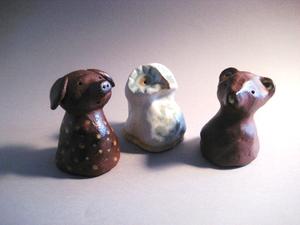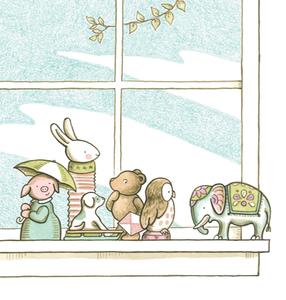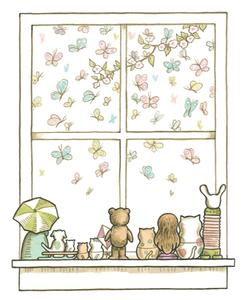
|
|
| photo: Michelle Corpora | |
Kevin Henkes was just 19 when he braved the wilds of New York City to sell his first picture book to Susan Hirschman of Greenwillow Books, and he has been making children's books with Greenwillow ever since. "It's the only real job I've ever had," he says. He won the 2005 Caldecott Medal for Kitten's First Full Moon, a Caldecott Honor for Owen and Newbery Honors for his novels Olive's Ocean and The Year of Billy Miller. In his new picture book, Waiting, the whole world is distilled into 1) five toys who wait on a windowsill; 2) a window; and 3) the four seasons that unfold outside. Henkes lives in Madison, Wis., with his wife, Laura Dronzek, who is also a children's book illustrator, and their two children.
What inspired you to write a story about waiting? Is this an existential ode? Are we all waiting on the windowsill of life?
If you look at the copyright information page of Waiting, you'll see the Library of Congress classified it as "Philosophy - Fiction." I loved that! That was a new one for me. I can't always pinpoint where my books begin, but I can with this one. It started in 2006 in my neighborhood clay studio. I've been making hand-built sculptures, mostly animals... 150 of them! Many of them are on the windowsill and I look at them every day... the way they are sitting. They look like they are looking out the window, waiting. I've been thinking about waiting.

|
|
| Three of Kevin Henkes's clay figurines that inspired the picture book Waiting | |
Kids wait all the time. They wait in line, they wait their turn, they wait for their snack, and for naptime to be over. They wait for birthdays, for the birth of siblings, they wait to graduate from car seats. Wait is a word like yes or no. It's part of their daily lives. "Can I go now?" "Wait."
We live in a culture of instant gratification... and yet kids still have to wait. All these thoughts about waiting meshed with these characters on the windowsill. Usually what I do in my books is take something small and make it large. Here I wanted to take something large and make it small, like the changing of seasons. I wanted to include the idea that while you're waiting, something else happens. How life is full of unexpected moments of joy or sadness or wonder.
How did you decide what sort of artwork best suited the book?
Originally I thought I would photograph my clay sculptures, something I hadn't done before. But I realized I'm much better at drawing. And I wanted the toys to be able to move their eyes and tilt their heads. That opened up a whole new set of problems. The terror and joy of making a book!
You ended up using brown ink, watercolor paint and colored pencils. What was your process?
At first I thought I'd do the figures in black and white. I tried black ink and black pencil, with everything outside the window in color, but didn't like the way it looked. And if you were interpreting the choice to mean the outside was better than inside, I didn't like that at all. So I tried different things. I used brown ink like I did in A Good Day and in Old Bear. I used a limited watercolor palette for the figures--four colors--then mixed them. Colored pencils were for everything outside the window.
 The owl waits for the moon, the pig for rain, and so on. Do you feel like you are waiting for something in particular?
The owl waits for the moon, the pig for rain, and so on. Do you feel like you are waiting for something in particular?
When I don't have something to work on, I'm always waiting for the idea for the next book. Having a book to work on is like an anchor in my life, and when I don't have that I feel unmoored, and life feels slightly unpleasant. This book was a long time coming--I couldn't figure it out--and then, finally, I did.
What were the obstacles?
After I decided I wouldn't photograph the sculptures, I was trying to think of what the windowsill toys should be... people or animals? I went back and forth. The pig with the umbrella was a boy and the bear with the kite was a girl, and the puppy on a sled was a baby. I drew many sketches both ways. I thought of getting someone else to illustrate it. I thought I would never finish this book. And I did that thing I often do, which is to wish I were doing a novel instead of a picture book, because novels are so much easier. (When I work on novels, I think picture books are easier.) And I thought, [my editor] Virginia [Duncan] will tell me what to do! But she said, "You'll figure it out."
So once you decided on animals over people, you ended up with a pig, owl, bear, dog and rabbit as your characters. Did you consider any other ideas... like a hamster or a lizard?
There was a rooster waiting for the sun at first, rather than the owl waiting for the moon. But then it would be nighttime while he was waiting for the sun, and I didn't want to deal with that in the art. It's funny how every decision leads to many more decisions, every choice leads to other choices that need to be made.
Tell us about the rabbit. Is he based on an actual squeeze-box toy you have?
The rabbit is based on a toy that my son had when he was a toddler. It's a springy toy with a head on top, but it was a human, not a rabbit. The rabbit is my favorite. He came to me first. The others are waiting for something, but he's just happy looking at the window. So he's the most centered, and the cover illustration was my way of showing that. The pig and the bear are both represented in the clouds by the umbrella and the kite, their "security objects," and the owl and the puppy (the old and the young) are represented in the sky with the owl flying high and the puppy running free. They are projections of a different existence, free from constraints, and the rabbit is the only one with an accurate representation of himself in the sky. And he's stretched to his fullest extent on the cover, the tallest he can be. Those kinds of things matter to me. Those kinds of decisions make bookmaking interesting to me day in and day out.
When I read Waiting to a three-year-old, and we came to the part where the elephant falls off the windowsill and breaks, she looked up at me sharply, as if she were looking at my face to see how she should react. Did you include the elephant as an acknowledgment of loss or death? What did you have in mind?
Kids deal with disappointment daily, great and small. With the cat and the elephant I was thinking about birth and death. Yes, the elephant was a death. I couldn't not think that. The cat really balances that out and in a certain way makes the elephant part okay. I've only read the book aloud to groups a couple of times so far, but there is a huge gasp when the elephant breaks, and a collective AHHH when the cat has kittens. Opposite effects.
 Do you stare out the window a lot?
Do you stare out the window a lot?
My studio is up in the attic and there are five windows up here, so, yeah, I guess I do stare out the window a lot.
Can you see fireworks from your window like the toys can from theirs?
You can see fireworks from my window. I think windows are a great place to wait. I remember as a kid waiting at the living-room window, waiting for my father to come home from work, for my older siblings to come home from school. I remember breathing on my window and drawing on it, or scraping frost with my finger. The other place I loved was the window in my bedroom, especially in the summer. I loved putting my pillow at the foot of the bed, my head by the window. I like that waiting and window both begin with w, confirming that they belong together! For a while I toyed with calling this book Window, but I think Waiting is nicer.
I like that Waiting is a little mysterious. It allows you to fill in the blanks. You are not supplying all the answers.
I wanted it that way. I thought about adding a floor, a rug, the hand of a child, for context. I got rid of everything, so whoever was reading it or listening to it would make it their story, too: Who leaves them the gifts? What else is going on here?
We are all waiting to see what will happen next with you. What are you working on these days?
Waiting is definitely on my mind. I have a picture book called When Spring Comes with my wife, Laura Dronzek, due out in spring 2016. There's a lot of waiting in the book. There's another picture book I'm illustrating called Egg and there is a lot of waiting in that, it's mentioned maybe 17 times. --Karin Snelson

